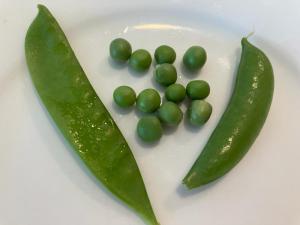In the market or garden, it’s time to pick peas
This is the best time of year for fresh peas, which will be in season from now until mid-May. You’ll be able to find fresh peas in three different styles: green peas, snap peas and snow peas. The first of these are sometimes called “sweet peas” because of their delightful flavor, but don’t confuse them with the flowering plant known as the sweet pea – it’s lovely in a garden, but its seeds are toxic.
Often considered our oldest food, peas have been cultivated for over 10,000 years. Evidence of wild pea plants has been found in Neolithic archeological sites in Turkey and Iraq. At that time, they would have been dried and then incorporated into a boiled dish; think of split-pea soup made from dried peas. Evidence of peas being eaten in their fresh state dates to the Bronze Age in Switzerland.
Food historians cite Catherine de Medici, wife of French King Henry II, as the source of the 16th-century food fad that led people to eat fresh green peas. Like so many other plants, peas were brought to the Americas by Columbus, and by the 17th century, they were being cultivated in Jamestown. When planting his gardens in Monticello, Thomas Jefferson included peas; he reportedly hosted an annual contest with his neighbors to see whose crop could be harvested first.
Sweet peas are sometimes called English peas because of the great interest in that country for breeding strains that would be especially sweet and tender. Although pea plants didn’t come to America originally from England, the name acknowledges how much work was done to develop popular cultivars. And, if you have ever heard of “mushy peas,” they are made with an entirely different legume called marrowfat peas.
The other two types of peas you’ll see in the produce aisle are sold without removing the external pods. Snap peas are slightly chubby with rounded ends, while snow peas are flatter with small, immature peas inside. If you shell snap peas, you’ll find sweet, green peas within, but if you prefer to eat them whole, the tender peas are a nice contrast to the crisp pod.
The pods of snow peas are not removed because the peas are too small to be used on their own. Snow peas are a common ingredient in stir-fried dishes, and in the pasta recipe in the photo, they’ve been trimmed in half. They offer a nice crunch to contrast with the pasta and tender green peas.
When shopping for peas, try to avoid the cellophane bags that are designed for steaming in the microwave, as you won’t have much control over the condition of the contents. Fresh English peas should have bright-green pods and a fresh, sweet flavor. Choose pods that swell with their contents and appear firm. For the best flavor, shell the peas yourself, a quick task that’s worth the time. Snow peas should be flat, smooth and bright green.
Store any of these peas in the coolest part of your crisper drawer in the refrigerator; you’ll want to eat them within a day or two of purchase. I’ve included a recipe for the pasta dish in the photo; although it features elbows, you can use almost any shape of pasta. The snap pea recipe comes together quickly and works well as a side dish with chicken or fish. A combination of sauces in the snow pea dish adds some salty heat to a simple stir-fry. Now’s the time for peas!
3 Pea Pasta
1 lb pasta
8 oz sugar snap peas
8 oz snow peas
8 oz green peas
1 T olive oil
1 T butter
1 minced shallot
1 T rice wine vinegar
salt & pepper, to taste
grated Parmesan cheese (optional)
Prepare the pasta according to the package directions. When cooked to al dente, drain and reserve 1/2 C of the cooking water. While pasta cooks, rinse and drain the snap peas; set aside. Rinse and drain the snow peas; remove any strings, cut in half crosswise, and set aside. Rinse and drain the green peas; set aside. Heat the olive oil and butter in a large skillet. Add shallot and cook until softened, about 2 minutes. Add the snap peas and cook, stirring often, for about 2 minutes. Add snow peas and cook for a minute. Add green peas and cook for a minute. Stir in cooked pasta, vinegar and some of the reserved water to deglaze the pan. Season to taste with salt and pepper. Garnish with grated Parmesan cheese, if desired. Yield: 8 servings.
Lemon Snap Peas
8 oz sugar snap peas
1 T olive oil
1 minced garlic clove
salt & pepper, to taste
2 t grated lemon zest
Rinse the peas; remove any brown tips and strings. Heat oil in a large skillet over medium-high. Add the peas and toss to coat with oil. Add garlic and cook, stirring often, until crisp-tender, about 5 minutes. Season to taste with salt and pepper; toss with lemon zest. Yield: 3 or 4 servings.
Sautéed Snow Peas
8 oz snow peas
2 t sesame oil
1 t soy sauce
1/2 t chili sauce
1 t sesame seeds
red chili flakes for garnish
Rinse and drain the snow peas. Remove the tip and peel away the thick string along the side. Heat sesame oil in a heavy skillet over high. Add snow peas and cook, stirring continuously, for about 2 minutes. Add sauces and toss to coat. Sprinkle with sesame seeds and garnish with chili flakes. Yield: 4 servings.






















































